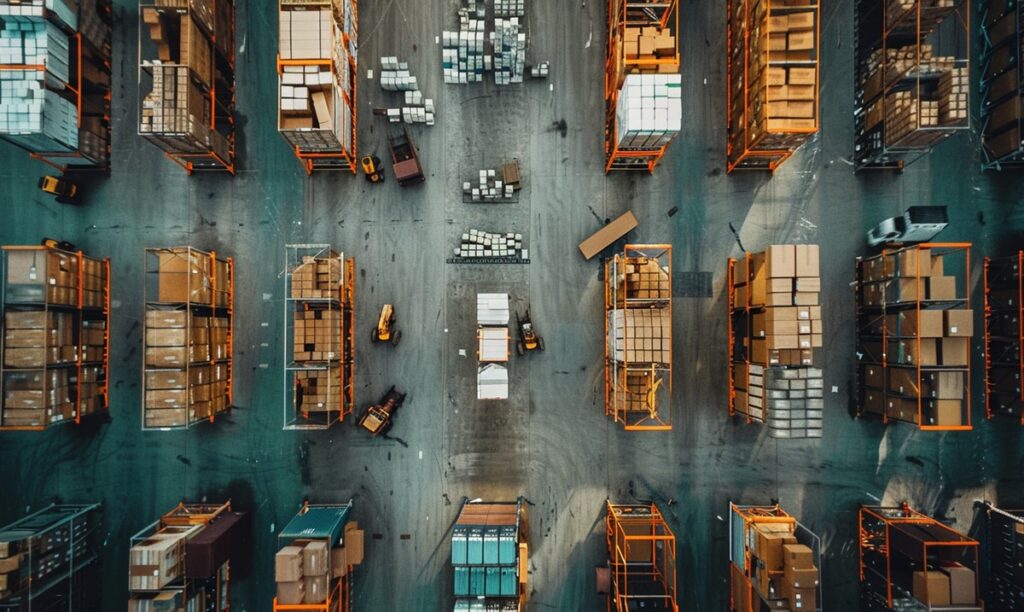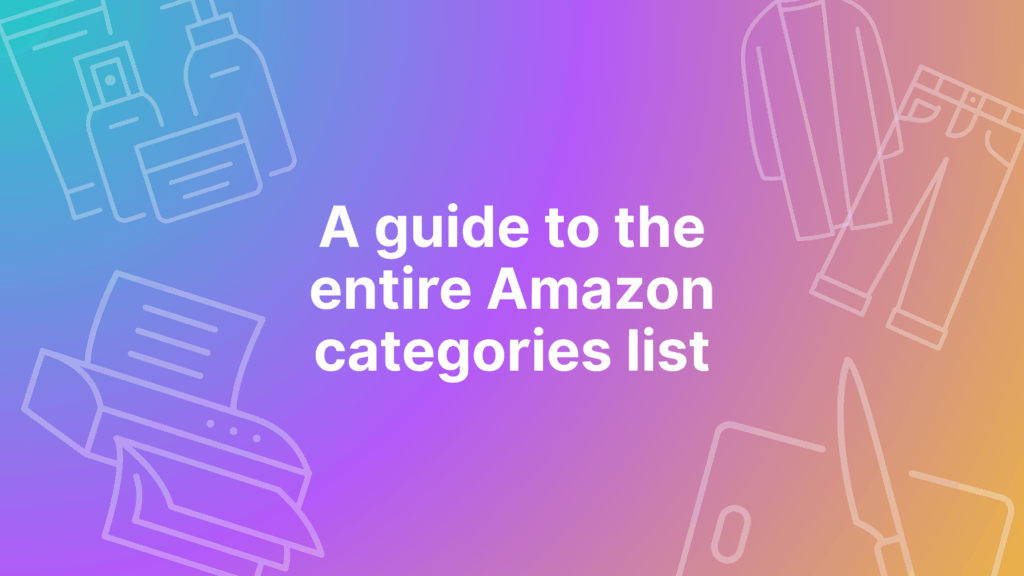- Blog
-
For Sellers
The complete guide to retail arbitrage on Amazon in 2025
Our retail arbitrage guide shows you exactly where to shop, what to buy, and how to scale.
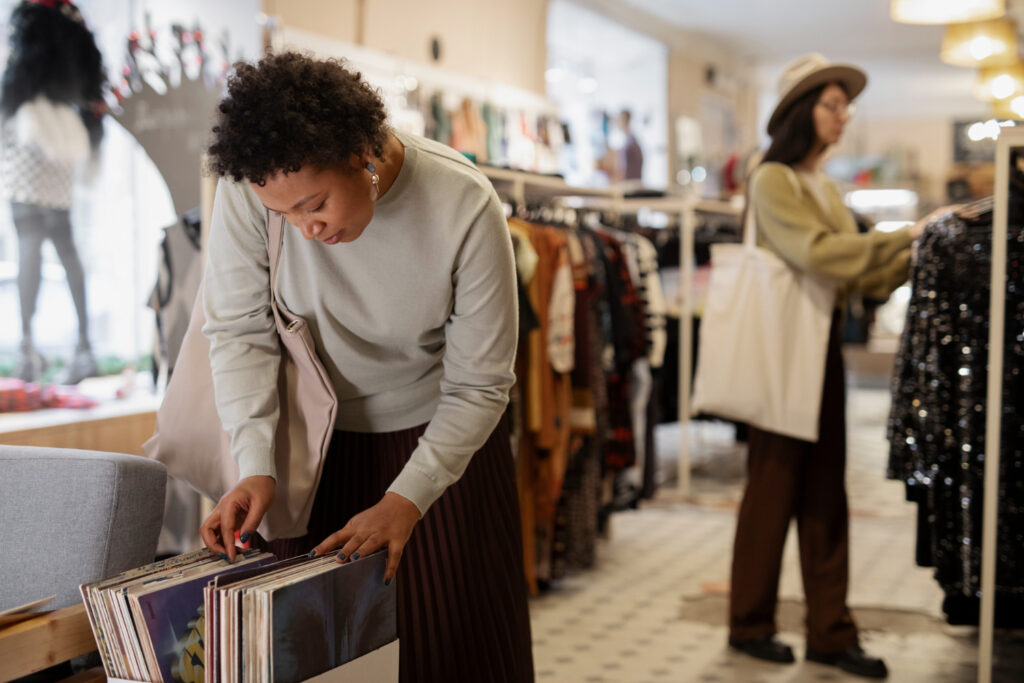
Are you interested in selling on Amazon but don’t have the budget to launch a private label product, or don’t know where to begin? Retail arbitrage might just be your golden ticket. And you can start with as much or as little money as you’re comfortable with.
Don’t feel like reading? Listen to this article in our podcast, Commerce Decoded.
What is retail arbitrage and why it’s still profitable in 2025
Retail arbitrage is the art of buying discounted products from retailers and reselling them on Amazon for a profit. For example, you spot a $5 kitchen gadget at Walmart, scan it with your phone, and discover it’s selling for $20 on Amazon. Congratulations—you’ve just found arbitrage gold!
This business model is perfectly legal thanks to the first-sale doctrine, which states that anyone who legally purchases a product can resell it if it remains in unchanged condition. So no, Amazon police won’t be knocking on your door (unless you’re breaking other rules, but we’ll get to those later).
Now, despite what some doomsday prophets have been saying for years, retail arbitrage is alive and thriving in 2025. Why? Because retail pricing inefficiencies continue to exist, and where there’s inefficiency, there’s opportunity.
Retail arbitrage vs. other Amazon business models
Before you dive headfirst into arbitrage, let’s see how it stacks up against other ways to make money on Amazon:
| Business model | Startup cost | Time to launch | Profit margins | Risk level |
| Retail arbitrage | $500 to $2,000 | Days | 30 to 80% | Low |
| Private label | $2,000 to $10,000+ | Months | 40 to 60% | High |
| Wholesale | $3,000 to $10,000 | Weeks | 20 to 40% | Medium |
| Dropshipping | $0 to $500 | Days | 10 to 30% | Medium |
| Handmade | $500 to $2,000+ | Weeks | 40 to 70% | Medium |
Unlike private label, where you’re betting thousands on product development and inventory before making a single sale, retail arbitrage lets you test the waters $20 at a time.
But the real beauty of arbitrage is its forgiving learning curve. Made a bad buy? You might be out $10. Whereas if you made a bad private label decision, you might be looking at $2,000 in unsellable inventory collecting dust (and storage fees) in Amazon’s warehouse.
Essential tools for successful retail arbitrage
While technically you could start with just the free Amazon Seller App, having the right tools set you up to succeed better.
Amazon Seller App
The Amazon Seller App is your no-cost entry point that allows you to:
- Scan product barcodes while shopping
- Check profitability after Amazon’s fees
- See if you’re allowed to sell a product
- Monitor your sales on the go
- Manage orders and customer messages
ScoutIQ
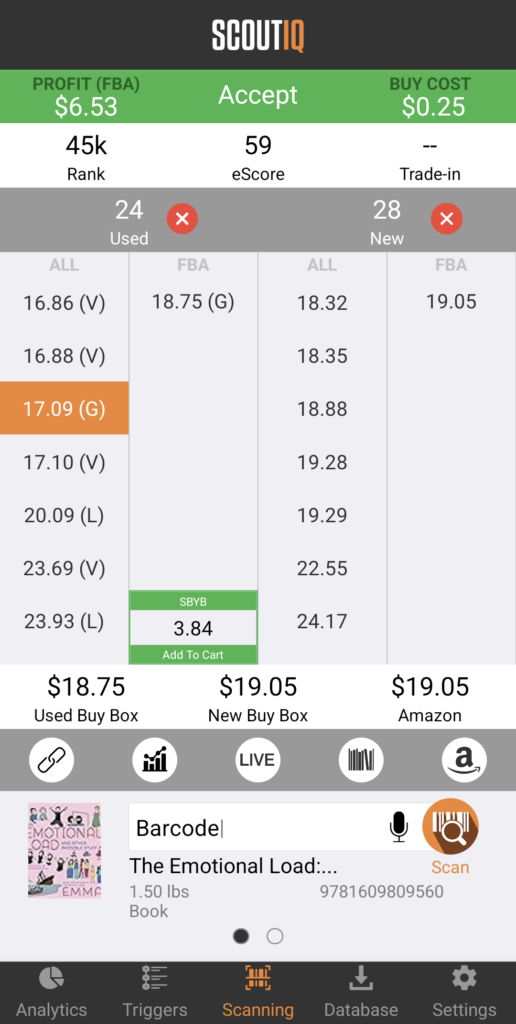
If books intrigue you (and they should—they’re often the most profitable category for beginners), ScoutIQ is your new best friend. This mobile app lets you:
- Scan books rapidly in thrift stores or library sales
- See real-time profitability calculations
- Access sales history with the proprietary eScore system
- Work offline when cellular service is spotty
Scoutify
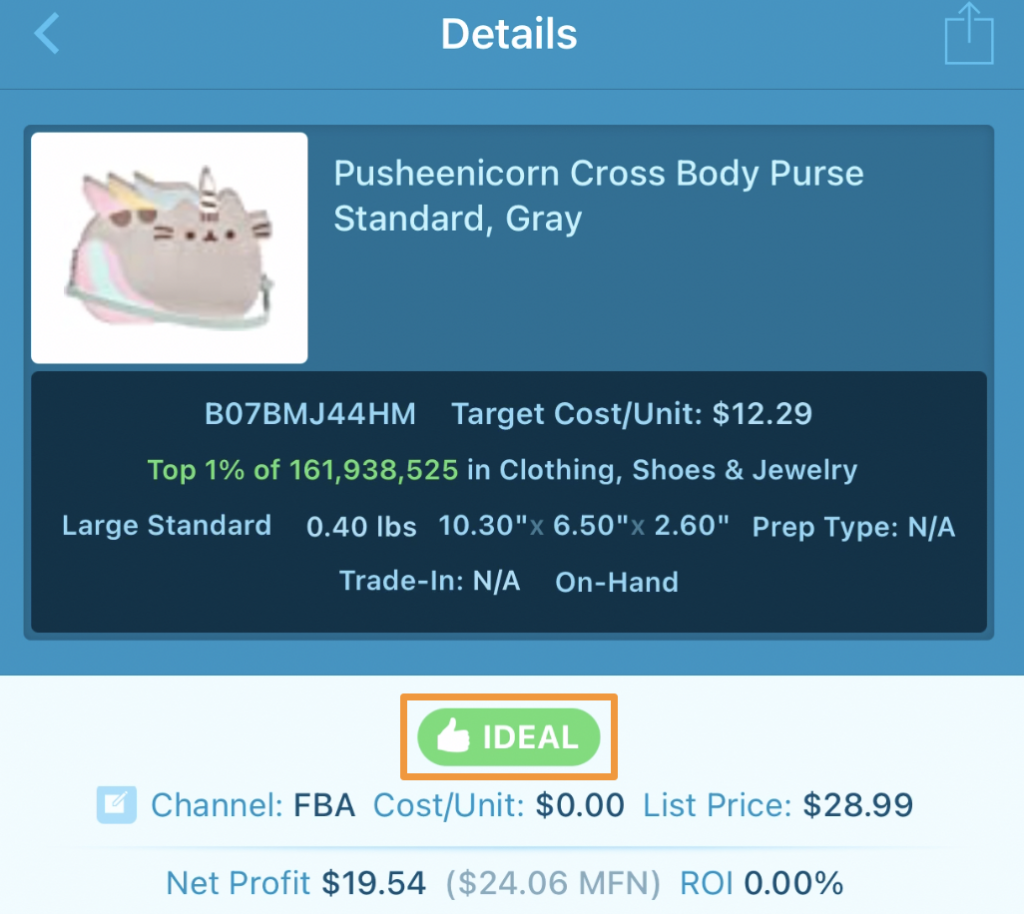
For general retail arbitrage scanning, Scoutify outperforms the Amazon Seller App in every way. It’s faster, more detailed, and built specifically for in-store sourcing. Key features include:
- Instantaneous barcode recognition
- Profit analysis with all fees calculated
- Restriction alerts to prevent buying unsellable items
- Custom buy triggers based on your criteria
InventoryLab
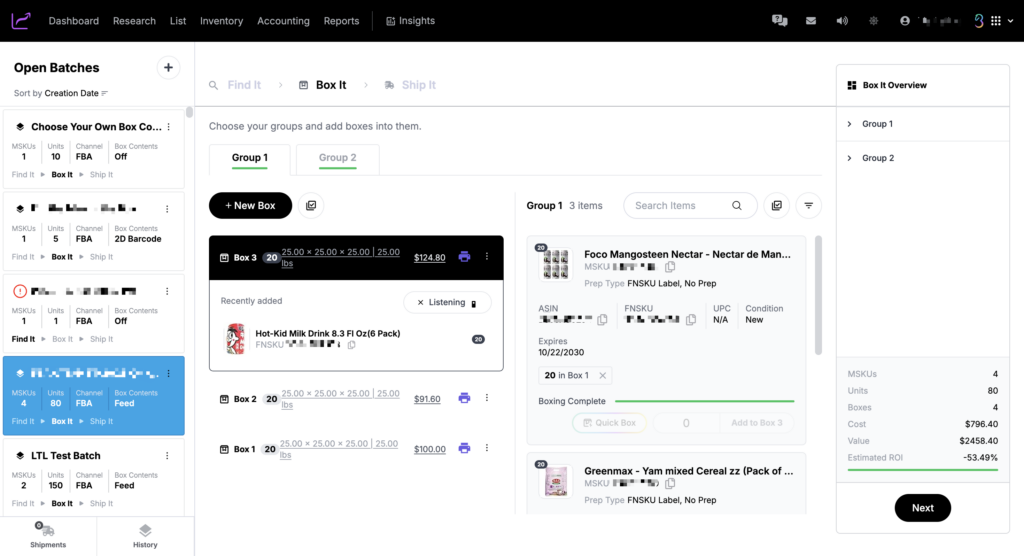
Once you’ve found items to resell, InventoryLab streamlines the process of getting them into Amazon:
- Create Amazon FBA shipments effortlessly
- Print all required labels in seconds
- Track your cost of goods and profitability
- Generate tax-ready accounting reports
SmartRepricer
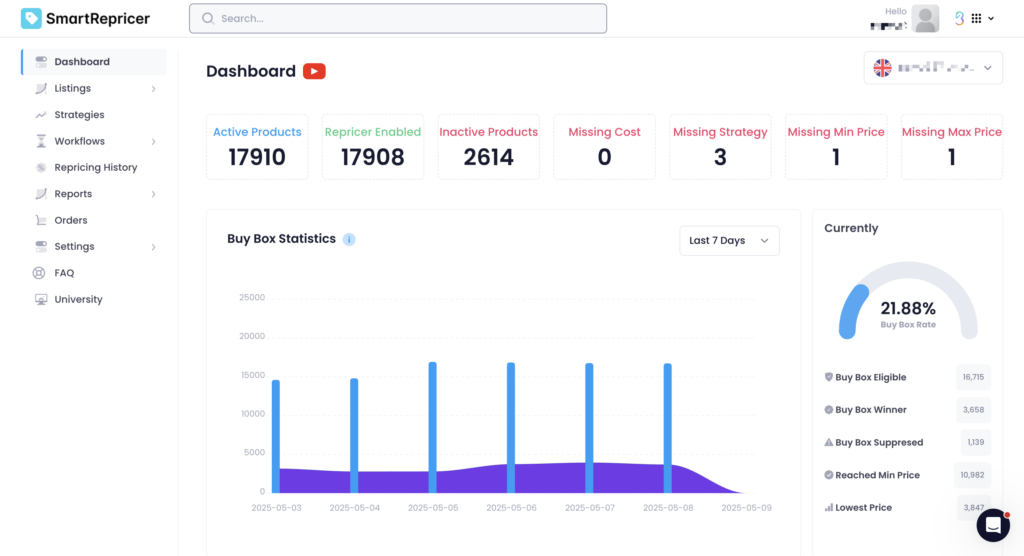
As your inventory grows, manually adjusting prices becomes impossible. SmartRepricer automatically optimizes your pricing to:
- Win the Buy Box more frequently
- Adjust to market fluctuations 24/7
- Maintain your profit margins with price floors
- Maximize revenue without constant monitoring
And here’s the good news. You can get ALL these tools and more bundled in Seller 365 for just $69/month. This saves you over $200 compared to subscribing separately. It’s like getting the arbitrage equivalent of a Swiss Army knife.
Step-by-step retail arbitrage process
1. Finding products
The treasure hunt is the most exciting part of retail arbitrage. Let’s break down where to look and what to look for:
Where to find profitable retail arbitrage inventory
Big box retailers like Walmart, Target, and Best Buy. Their clearance sections rotate regularly and creates constant opportunities. In fact, Target’s end-of-season clearance can hit 90% off. This means $50 items can be bought for $5, and you can then sell them for $25+ on Amazon.
Discount chains like TJ Maxx, Marshalls, and Ross also offer brand-name products at significantly reduced prices. But what makes these stores special is their irregular inventory. You’ll find items here that aren’t widely available elsewhere, so you’re less likely to have competition on Amazon.
Pharmacy chains like CVS, Walgreens, and Rite Aid might not seem obvious, but their clearance sections often contain hidden gems too. You just need to pay extra attention to the price tags and scheduled sale days.
Meanwhile, dollar stores are perfect for beginners since your risk per item is so low. A $1 name-brand toy can easily fetch $8 to 12 on Amazon during the right season. Dollar Tree, Family Dollar, and Dollar General should all be on your sourcing circuit.
Lastly, thrift stores require more digging but can yield extraordinary returns. This is especially true for books, board games, and discontinued items. Just make sure to use scanning apps like ScoutIQ to rapidly evaluate dozens of items.
Seasonal opportunities and timing strategies
Retail clearance also follows predictable patterns that you can exploit. Make sure to take note of the following:
- January/February: Holiday merchandise hits 90% off, summer goods start appearing
- April/May: Easter clearance, spring cleaning products, outdoor living
- July/August: Summer goods clearance, back-to-school begins
- October/November: Halloween clearance, early holiday items
Pro tip: Buy for next year’s season during this year’s clearance. That Christmas wrapping paper at 90% off in January will sell for full price come October!
Discontinued products
Another strategy you can adopt in retail arbitrage is finding discontinued products that still have demand. People become emotionally attached to products, and when manufacturers discontinue them, desperate customers will pay premium prices.
Look for:
- “Clearance” or “Discontinued” tags
- Older packaging designs
- Dusty items on the back shelves
- Products mentioned in online forums as “discontinued favorites”
2. Analyzing profitability
Finding inventory is only half the battle. Determining if it’s actually profitable requires understanding Amazon’s fee structure.
An easier way to do this is to use Scoutify to scan the product’s barcode. Just head over to the Profitability tab and you’ll see the following:
- Current Amazon selling price
- Amazon referral fee (typically 8 to 15%, depending on category)
- FBA fulfillment fee (based on size and weight)
- Monthly storage fee (varies by time of year)
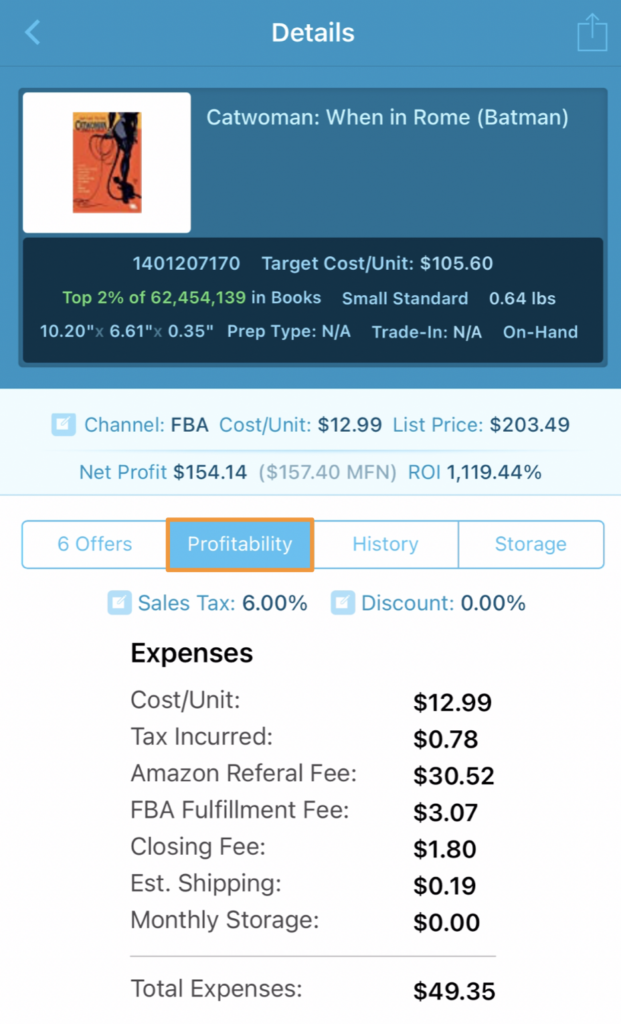
Let’s break down a real example:
Imagine finding a board game at Target for $12 on clearance:
- Amazon selling price: $34.99
- Amazon referral fee (15%): $5.25
- FBA fulfillment fee: $5.92
- Monthly storage (standard size): $0.32
- Your purchase price: $12.00
- Net profit: $11.50
You nearly doubled your money on a single item!
However, remember to factor in these potential profit killers as well:
- Sales tax on your purchase
- Prep supplies if required
- Return rate for the category
- Price fluctuations after you buy
A good rule of thumb: aim for 50%+ ROI for standard items, 100%+ for slower-moving inventory. This buffer protects you from price drops and unexpected costs.
3. Making purchase decisions
How many units should you buy? This comes down to:
- Sales velocity: How quickly will it sell? Check the BSR (Best Sellers Rank).
- Competition: How many sellers are offering the same item?
- Capital constraints: How much of your budget can you allocate?
- Storage considerations: Will it sell before long-term storage fees kick in?
For beginners, we recommend the 3-5 rule: Buy 3-5 units of any new product to test the waters. If they sell quickly and profitably, return for more. This limits your downside while still giving you meaningful data.
As you gain experience, you’ll develop instincts about when to go deep on inventory. There are sellers who buy 50+ units of the same toy during clearance season, knowing it will sell throughout the year.
4. Creating Amazon listings
Unlike private label, retail arbitrage means selling on existing Amazon listings. You basically start by uploading a spreadsheet or inventory file, making sure that all relevant information is provided for each product so Amazon can match it to existing products.
You’ll be prompted to enter UPCs or ASINs (found through scanning), select the condition, and set your price. You will then be able to create a unique SKU and prep for FBA shipment.
Pro tip: Never be the seller who dramatically undercuts the current price! Price within 1-2% of the current Buy Box to maintain market value.
5. Preparing and shipping to FBA
Getting your inventory to Amazon efficiently ensures that you get the maximum profit possible for your items:
- Create a shipment in Seller Central by going to your inventory and selecting “Send/Replenish Inventory”
- Print product labels (if not using manufacturer barcodes)
- Package items according to Amazon’s guidelines
- Create shipping plans (Amazon will tell you which warehouses to ship to)
- Print shipping labels and send packages
Tips to slash your shipping costs:
- Use Amazon’s partnered carrier rates (typically UPS) for major discounts
- Optimize box dimensions to avoid dimensional weight surcharges
- Consolidate shipments when possible
- Consider flat-rate boxes for very heavy items
Common mistakes to avoid:
- Insufficient packaging leading to damaged items
- Missing prep requirements for certain categories
- Sending restricted products that Amazon may destroy
- Creating shipments too small to justify the fixed shipping costs
InventoryLab makes this entire process nearly foolproof. You can automatically generate all needed labels and shipping plans with minimal effort.
Scaling your retail arbitrage business
Once you’ve mastered the basics, it’s time to grow.
Implement these tracking systems
As your business grows, you’ll need proper tracking systems to stay organized. Start by implementing inventory management software to monitor stock levels and age, ensuring you know what’s selling and what’s sitting.
Add COGS tracking for accurate profit calculations across your growing catalog, while conducting regular SKU performance analysis to identify your winning products.
Don’t forget to create reorder calendars for seasonal bestsellers, so you can capitalize on predictable demand patterns year after year.
Make strategic reinvestments
The path to scaling requires disciplined reinvestment of your profits. During your first 3 months, reinvest 100% of profits to build momentum quickly.
From months 4 to 6, adjust to reinvesting 80% while taking 20% as income to reward your efforts. As you progress through months 7 to 12, shift to reinvesting 70% and taking 30% as income as your business stabilizes.
By year 2 and beyond, consider diversifying into other Amazon models like wholesale or private label while maintaining your arbitrage foundation.
Expand into online arbitrage
As you grow, online arbitrage becomes the natural evolution of your business. This approach allows you to scale beyond geographical limitations, source products 24/7 without leaving home, and analyze significantly more products in less time.
The fundamental principles remain the same, but the efficiency increases dramatically with automation. Many full-time arbitrage sellers eventually transition to 80% online sourcing with just 20% traditional retail sourcing as they optimize their time and maximize profits.
Tactical Arbitrage can make this step even more straightforward. It scans thousands of products across 1,400+ websites to find profitable reselling opportunities while you sleep.
With it, you can:
- Compare prices across massive product databases
- Filter by ROI, sales rank, and competition
- Discover “hidden” profitable products others miss
- Research from home in your pajamas
Get started with retail arbitrage today
Ready to launch your Amazon retail arbitrage business? Here’s your quick-start checklist:
- Create an Amazon seller account
- Download essential tools:
- Amazon Seller App (free to start)
- Seller 365 for the complete toolkit
- Set aside initial inventory budget
- Visit your first sourcing location
- Look for products with 50%+ ROI potential
- Purchase 3 to 5 units of 3 to 5 different products
- Create your first FBA shipment
- Track results and repeat what works
Your first profitable flip is waiting. Why not find it today?
Want to fast-track your success? Try Seller 365 free for up to 14 days and get instant access to 10 powerful seller apps for just $69/month after your trial.
FAQs about Amazon retail arbitrage
Yes, retail arbitrage is completely allowed on Amazon and protected under the first-sale doctrine, which gives you the right to resell products you’ve legally purchased. Just be aware that certain categories and brands may require approval before selling, and always ensure products are in the condition you claim.
A common example of retail arbitrage is purchasing clearance toys at Target for 75% off (like a $20 toy for $5), then reselling them on Amazon for close to the original retail price. Other examples include finding discontinued kitchen appliances at TJ Maxx or buying books at thrift stores that sell for much higher prices online.
Retail arbitrage is one of the lowest-risk ways to start selling on Amazon since you can begin with minimal capital and quickly test what works. The only main risks are price volatility after purchase, restricted products you can’t sell, and items that might sit in inventory longer than expected.



















